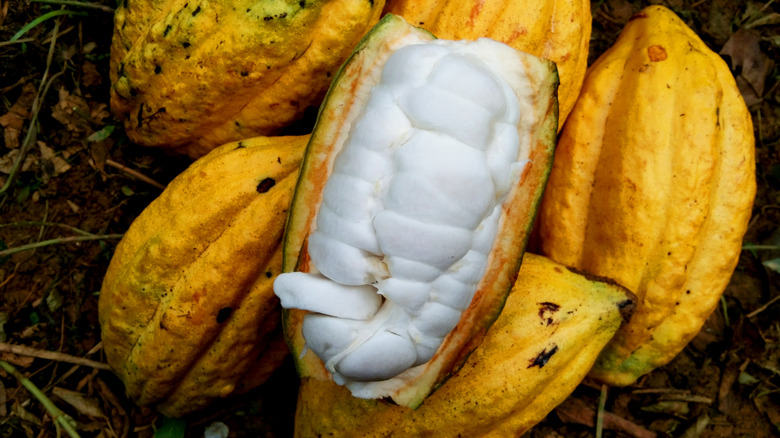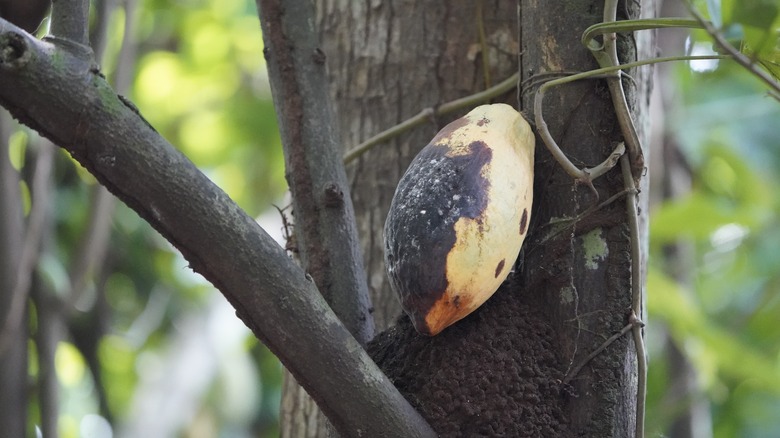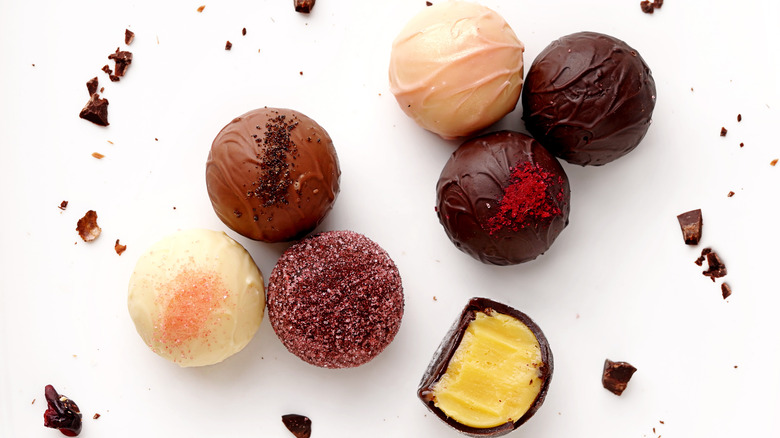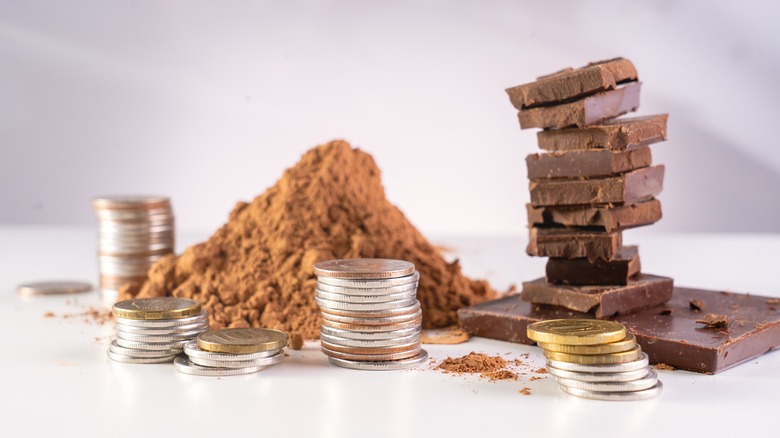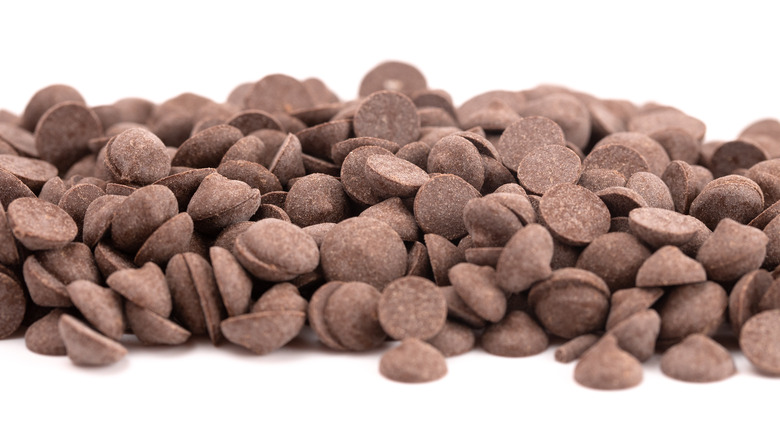Why Chocolate Is So Expensive In 2024, And What This Means For Your Favorite Candies
One of the hallmarks of a market-based economic system is the fluctuation in cost of goods and services based on supply and demand. While many commodities have seen unprecedented inflation due to supply chain challenges, one particular product has experienced record-breaking price increases — cocoa. As CNBC reports, in April of 2024, cocoa prices peaked at a cost of $11,000 per metric ton, up from roughly $2,500 in previous years. This represents an increase of over 300%, which has created something of a quandary for chocolate and candy producers, who have had to become resourceful and creative in meeting the increasing consumer demand for confectionery treats.
Daily Meal spoke to Carly Schildhaus of The National Confectioners Association, who explained that confectionery sales hit $48 billion in 2023 and is expected to jump to $61 billion by 2028. As she says, "In this environment in which consumers are facing higher food prices, people are looking for ways to manage their own personal costs — yet at the same time, consumers are still turning to the confectionery category to help them elevate their most cherished moments."
To more clearly understand how rising cocoa costs impact the candies that we have all come to know and love, it's important to take a closer look at the supply chain itself — how it works, why it has been impacted, and what the future may hold. Let's take a deep dive into why chocolate is so expensive in 2024, and what this means for your favorite candies.
How exactly does cocoa go from a bean to becoming a chocolate bar?
To fully comprehend why the cost of cocoa impacts the price you pay for your favorite chocolate bar, it is important to understand the bean-to-bar pipeline. Modern-day chocolate has its origins in ancient Mesoamerica, where cacao beans were valued both as a currency and as a food source. It wasn't until they made their way to Europe during the Columbian Exchange that the chocolate bar as we know it came to be.
The chocolate-making process begins with gathering the pods from Theobroma Cacao trees, which grow predominantly in countries along the Equator. Within these pods are beans that must be fermented, dehydrated, and roasted before they can be transformed into cocoa nibs. These nibs are pulverized into what is known as chocolate liquor. This liquor can be further processed, yielding both cocoa solids and cocoa butter, which is the most expensive component in chocolate.
To produce a chocolate bar, the liquor extracted from cocoa nibs is combined with sugar, milk powder, and cocoa butter before it is conched, a process that involves gentle heating and blending until the mixture is velvety and creamy. Once tempered, the chocolate can be transferred to molds where it is morphed into the shape of a bar. For perspective, it requires between 400 and 600 cocoa beans to produce just one kilogram or 2.2 pounds of chocolate, highlighting how capricious and susceptible to disruption the bean-to-bar pipeline truly is.
What is driving the increases in cost of chocolate?
The issues driving the increased cost of cocoa are manifold, but the fundamental cause comes down to the limited capacity for Theobroma cacao trees to grow. A vast majority of all cocoa used to produce chocolate, roughly two thirds, is sourced from West Africa, specifically the Ivory Coast and Ghana. This area is particularly susceptible to extreme weather driven by climate change.
As Carly Schildhaus mentions, "There are specific environmental factors like unpredictable weather patterns in origin countries that are applying pressure to the cocoa supply chain." Not only have the temperatures in cocoa farming regions been unprecedentedly hot in recent years, but variations between extreme rainfall followed by drought have made conditions ripe for the spread of a number of diseases afflicting the trees. This includes Black Pod Disease and Swollen Shoot Virus, which have decimated the Theobroma cacao tree population.
Another issue facing cocoa farmers has been the proliferation of illegal gold mines, as reported by Sustainability By Numbers. Farmers living below the international poverty line are abandoning their trade and renting or selling their land to opportunistic gold mining ventures, who will pay them far more than they could earn from producing cocoa. Additionally, thanks to price-fixing by these governments, farmers are not benefitting from the higher global returns, further marginalizing them and inhibiting their ability to reinvest in higher-yielding trees or disease-mitigating resources. Throw in volatile global financial markets and the situation becomes incredibly complex.
How has this increase impacted chocolate and candy producers?
Most major confectionary giants already have long-term negotiated contracts for cocoa, as CNBC notes, freezing the prices they pay and buffering them from the initial cost increases. At the same time, companies including The Hershey Company and Mondelez International have responded to the increased cocoa prices by raising the cost of chocolate-based treats. CBS News reports that the Mondelez brand has also been purchasing chocolate less often when discounts are made available.
Where these price increases are playing out more directly is among cocoa processors. Switzerland's Barry Callebaut and Blommer Chocolate Company (owned by Japanese cocoa processor Fuji Oil Holdings) are among those who have announced the shuttering of manufacturing plants and significant reductions in their workforces. Additional reactions remain to be seen, but upcoming changes are anticipated across the industry, depending on how quickly and aggressively cocoa prices are brought down to more manageable levels.
What are possible solutions to mitigating the chocolate crisis?
The solution to the chocolate crisis is twofold, with one side proactive, the other reactive. Assuming climate change will continue to be an unresolved issue in the foreseeable future, the proactive approach addresses the underlying systemic issues driving shortages in cocoa supply. These include diversification of the cocoa supply and investments in disease-resistant crops and pest management strategies, which is costly but doable. Unfortunately, the resources are lacking for these changes to be made on a large enough scale to produce a significant change. Additionally, until cocoa farmers are being paid a sustainable living wage, which would prevent them from switching to different crops or selling out to mining syndicates, the likelihood of dwindling cocoa plantations is high.
From a reactive perspective, confectionary companies have to re-evaluate the purchasing, production, packaging, and pricing options of their chocolate-based product lines to offset increased costs. This may include reworking recipes to include less chocolate or substituting the chocolate altogether with alternative ingredients. It could also involve searching for less costly packaging materials, developing new lines of confections that eliminate the need for chocolate altogether, or limiting chocolate-based items to seasonal, premium, or limited-time-only offerings. And, of course, passing those increased costs off to the consumer is an option, but is one that runs the risk of alienating consumers or reducing market share of its products.
Are chocolate prices expected to go down in the near future?
Though cocoa prices have started to cool since their peak in April, the question of whether the commodity will return to pre-spike levels remains open-ended. Without meaningful systemic changes, the driving forces behind the skyrocketing prices are unlikely to be resolved. Climate change will continue to exacerbate the poor growth of cocoa trees, while farmers will likely persist in seeking alternatives that can provide them with a more sustainable way of life.
There is another question that remains salient when considering the future of cocoa prices — the European Deforestation Regulation (EUDR), which is due to go into effect at the end of 2024. This directive prohibits the import of risk commodities, including cocoa, that have been sourced from deforested land, and may further restrict the supply of cocoa, which is likely to negatively impact costs.
Ultimately, the deciding factor comes back to the topic of supply and demand. If the demand for chocolate remains consistent and the supply does not markedly improve, it is unlikely that prices will return to pre-2024 levels. That said, if the current crop of cocoa, which should be harvested between October and February, is abundant, this may help to re-stabilize costs somewhat in the short-term. In the interim, Carly Schildhaus asserts that "companies continue to work diligently alongside their retail partners to do everything they can to manage down costs and make chocolate and candy accessible to consumers."
Alternatives to chocolate in candy making
While it may sound impossible to replace chocolate in candy making or to make high-quality chocolate desserts, the truth is, we may have to. Some common alternatives to chocolate run the gamut from marshmallows to caramel, nuts to gummies. Though these certainly provide sweetness and contrasts in texture, they do not fulfill the same niche that chocolate occupies.
One substitute that has long featured in vegan dessert recipes as a somewhat convincing facsimile of chocolate is carob. Carob is derived from a tree that originated in the Mediterranean. Often referred to as "poor man's chocolate," carob has long been revered for its inherently sweet, nutty flavor. It is also appreciated for its nutritional value, being high in fiber, calcium, and a number of vitamins and minerals. It can be transformed into sweetened or unsweetened chips that can be added to recipes one-to-one in place of chocolate chips. That said, the taste is distinctive and most chocolate chips are quite a bit sweeter in overall flavor profile than carob tends to be.
Lastly, when baking, pulverized dried fruits like cherries, dates, and figs, can confer a richness and sweetness that, while not quite like chocolate, delivers great flavor and a chewy texture. It will be interesting to see if food scientists will successfully discover alternatives that more accurately mimic the aromatic, textural, and flavor components of chocolate, but for now, depending on what the final product is, carob and dried fruits are likely the best alternatives.

